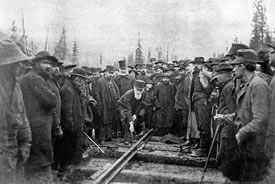Close ties to history at Crabbes River

The Last Spike (Photo by Library and Archives Canada, Wikimedia Commons)
When compared to the railcars that move across Canada daily, the Newfoundland Railway had a brief history, operating for just over 100 years. Moving freight and passengers across a largely unpopulated land, the railway linked remote Newfoundland together, not only allowing for the transportation of resources, but also opening the notion of the development for forestry, mining and hydro-electricity throughout the Dominion.
The story of the Newfoundland Railway cannot be told without emphasizing the role played by railway contractor Robert Gillespie Reid (1842-1908), a Scottish businessman who led the railway’s construction. Founder of Reid Newfoundland Company, Reid built, owned and operated the Newfoundland Railway from 1889 until his death. In addition to a variety of other business contracts he was awarded, Reid was granted a substantial amount of land in Newfoundland: a subsidy of 5,000 acres (2,023 hectares) of land for each mile of railroad operated.
On July 7, 1900, Robert G. Reid granted, for the sum of one dollar, a square mile of his land in Newfoundland to Sir William Van Horne. Sir William Van Horne was a railway giant himself; accredited with overseeing the construction of the Canadian Pacific Railway (CPR) to link Canada from coast to coast.
Appointed as General Manager of CPR in 1881 and promoted to President in 1888, Sir William Van Horne led the construction of the renowned Canadian Pacific Railway. This incredible engineering feat was completed under his leadership in 1885, six years ahead of schedule. He was present when a rail crew hammered in the infamous last spike, uniting the country from Montreal to Vancouver.
Van Horne’s drive and determination is cited as a major reason for the railway's rapid completion. Even more remarkably, once Van Horne had completed the CPR, he operated it and, despite the economic malaise for most of the 1880s and 1890s, made it into a paying proposition. Some of Van Horne’s other professional accomplishments include the launching of the Empress line of Pacific steamships and founding the famous Canadian Pacific hotels.

NCC conservation biologist Megan Lafferty inspects lands along Crabbes River, near St. Fintan's in western Newfoundland and Labrador (Photo by NCC)
For over 100 years, the plot of land that Robert G. Reid granted to Sir William Van Horne remained in the hands of the family of Sir William Van Horne, until recently.
A few years ago, the direct descendants of Sir William Van Horne approached the Nature Conservancy of Canada to discuss donating this historical piece of land for conservation. Just west of the T’Railway at Crabbes River is NCC’s Van Horne property — a piece of Newfoundland wilderness. Close to 610 acres (270 hectares) of dynamic forest divided by a wide-meandering salmon river, with a history as rich as the landscape surrounding it.
When I started my role as program manager with NCC in Newfoundland and Labrador, I had no idea that my first project would be one with such historical significance. Over the months of closing the land donation, I had the opportunity to explore the Van Horne property, examine the impressive original land deed and develop a relationship with one of Van Horne’s descendants.
Although the main railway line across the island was itself a major feat of engineering and political optimism, the Newfoundland Railway was not economically viable for a number of reasons. It was soon replaced with a cross-provincial highway and automobiles, and by 1990 the railway bed was removed, having been auctioned off, sold or scrapped. All that remains of the Newfoundland Railway is the vacant rail bed, now designated the "T'railway" — a linear provincial park.
The Van Horne property ensures that a special part of Canada's natural legacy will remain protected for all time.


